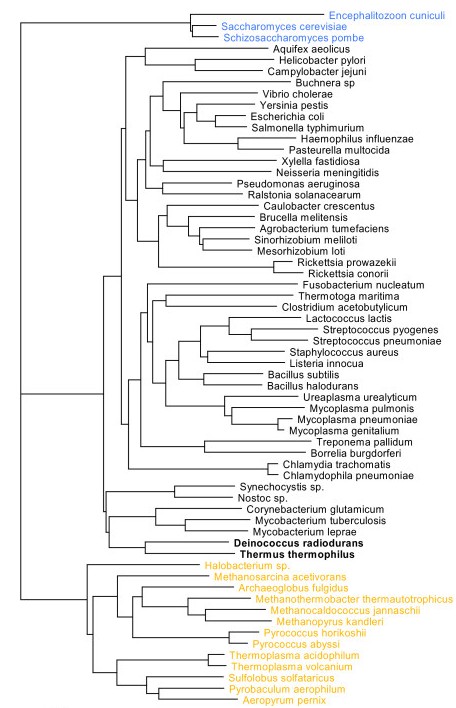Phylogeny
Classification of Deinococcus radiodurans has been difficult. It is not a member of the archaebacteria because it contains peptidoglycan in its cell wall, yet it contains genes that are not typical of other eubacteria. D. radiodurans was first classified in the genus micrococcus, which are a group of gram positive cocci. It was removed from that classification however after the discovery of its unique cell wall that contained L-ornithine and lacked teichoic acid in its peptidoglycan. Because of the unique cell wall and radiation resistance, it appeared that D. radiodurans and its related species belonged in a phyla of their own.
Upon the development of 16S rRNA technology, it was determined that the phyla Thermus and Deinococcus were related. Even though members of the phyla Thermus are radiation sensitive thermophiles and members of the phyla Deinococcus are radiation resistant mesophiles, it has become apparent that each lineage evolved from a common ancestor. When examining D. radiodurans and Thermus thermophilus, there is a great deal of homology between their megaplasmids. Among the genes shared between the two species, most are common to the majority of bacteria. Although, there is a small set of genes that are found only in Thermus and Deinococcus. These genes contain subunits that are characteristic of archaea genes. Genetics coupled with the extreme lifestyles seen in these bacteria indicate that the members of phyla Thermus-Deinococcus are the closest living relatives of the archeabacteria.

This is a phylogenic tree provided by Dr. Michael Daly. Deinococcus radiodurans is bolded in black next to Thermus thermophilus showing they have a common ancestor. The bacteria labeled in yellow are the archeabacteria indicating that D. radiodurans is a close living relative of more primitive bacteria.
Taxonomy
| Domain: Bacteria |
D. radiodurans is conisdered to be in the domain and kingdom of bacteria because of the peptidoglycan component of its cell wall. All of the members of class Deinococci are radiation resistant and the majority are mesophiles. The classification of D. radiodurans has been done primarily using analysis of 16S rRNA sequences. The only other genus besides Deinococcus that is found under class Deinococci is Deinobacter. This new genus was created upon the discovery of Deinobacter grandis, which is a radiation resistant bacteria with a rod-shaped morphology instead of the typical spherical cocci morphology characteristic of genus Deinococcus. There have been five species categorized under the genus of Deinococcus. They are Deinococcus erythromyxa, Deinococcus proteolyticus, Deinococcus radiophilus, Deinococcus radiopugnans, and of course Deinococcus radiodurans which are distinguishable using 16S rRNA sequencing. |
| Kingdom: Bacteria | |
| Phylum: Deinococcus-Thermus | |
| Class: Deinococci | |
| Order: Deinococcales | |
| Family: Deinococcaaceae | |
| Genus: Deinococcus | |
| Species: radiodurans |
Alright Alright... Enough of the background. Let's find out why Deinococcus radiodurans is so cool!!